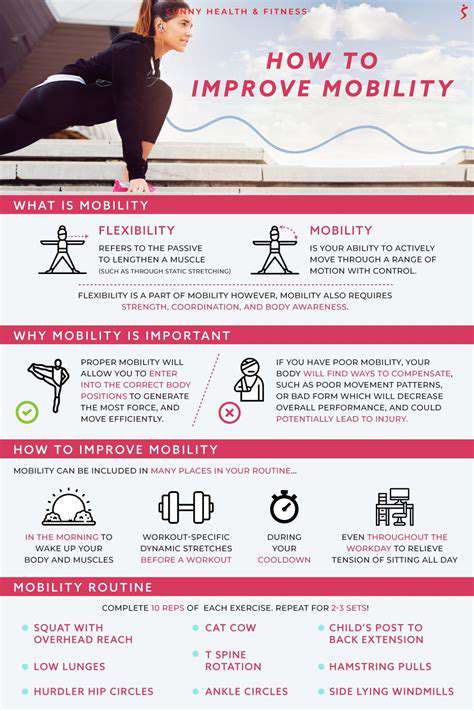Guide to Exercise for People with Arthritis (Safe Movement)
Understanding the Different Types of Arthritis
Arthritis isn't a single disease; it's a complex spectrum of conditions impacting joint health. While rheumatoid arthritis involves the immune system attacking joint tissues, osteoarthritis stems from gradual wear and tear. Accurate diagnosis forms the foundation for effective management, allowing healthcare providers to tailor interventions precisely. Early identification helps prevent long-term joint damage and improves quality of life significantly.
Consider psoriatic arthritis, which combines joint inflammation with skin symptoms. Each variation demands unique treatment strategies. Medical professionals emphasize that recognizing these differences enables more targeted care. This nuanced understanding helps patients navigate their condition with greater confidence and better outcomes.
Personalized Exercise Regimens for Arthritis
Movement matters profoundly for arthritis management, but one size doesn't fit all. Aquatic therapy offers exceptional benefits for those with severe joint pain, while others might thrive with tai chi or cycling. The secret lies in gradual progression and attentive body awareness. Many patients discover that short, frequent sessions work better than occasional intense workouts.
Collaboration with rehabilitation specialists proves invaluable. These experts craft regimens considering factors like disease progression, pain levels, and personal goals. Regular reassessment ensures the program evolves with changing needs, maintaining both safety and effectiveness over time.
Nutrition and Arthritis Management
Dietary choices influence inflammation significantly. Mediterranean-style eating patterns, rich in olive oil and fatty fish, demonstrate particular promise. Some individuals notice symptom improvement when reducing nightshade vegetables or processed foods. Food journals help identify personal triggers and beneficial choices, creating a customized nutritional approach.
Emerging research highlights the gut-joint connection, making probiotic-rich foods potentially valuable. Consulting with nutrition professionals ensures dietary changes meet all nutritional needs while targeting inflammation reduction specifically.
Lifestyle Modifications and Arthritis
Comprehensive arthritis care extends beyond medicine and exercise. Stress management techniques like guided meditation can lower inflammation markers. Sleep quality profoundly impacts pain perception, making good sleep hygiene essential. Weight management remains crucial, as each pound lost reduces knee stress exponentially.
Environmental adaptations, such as ergonomic tools and joint-friendly gadgets, make daily tasks manageable. Social support networks provide emotional resilience, completing the holistic approach to living well with arthritis.
Choosing the Right Types of Exercise
Aerobic Exercise for Joint Health
Cardiovascular activity remains fundamental, but selection matters immensely. Recumbent cycling protects vulnerable knees while still elevating heart rate. Many find elliptical trainers provide smooth motion without joint pounding. Consistency trumps intensity for sustainable benefits, making enjoyable activities paramount for adherence.
Interval training concepts apply gently - alternating two minutes of brisk walking with three minutes at comfortable pace. This approach builds endurance while respecting joint limitations. Monitoring perceived exertion helps maintain appropriate challenge levels.
Strengthening Exercises for Joint Support
Muscle acts as natural joint armor. Isometric exercises build strength without painful movement, ideal for flare-up periods. Resistance bands allow progressive challenge in home settings. Proper alignment during exercises prevents compensatory strain, making professional guidance invaluable initially.
Functional strength training translates directly to daily life - practicing chair stands improves toilet transfers, for example. Targeted core work enhances stability, reducing fall risk significantly.
Flexibility and Range of Motion Exercises
Gentle mobility work maintains joint function without exacerbating pain. Dynamic stretches in warm water leverage buoyancy for greater ease. Rhythmic movement meditation combines mindfulness with mobility, addressing both physical and emotional aspects simultaneously.
Passive stretching using props like yoga straps accommodates limited reach. Heat application before stretching increases tissue pliability, enhancing effectiveness while minimizing discomfort.
Low-Impact Exercises for Joint Preservation
Non-weight-bearing options provide alternatives when joints protest. Chair yoga adapts traditional poses for accessibility. Many community centers offer specialized arthritis-friendly fitness classes led by trained instructors understanding unique needs.
Aquatic Exercise for Arthritis Relief
Water's properties transform exercise possibilities. The combination of hydrostatic pressure and warmth reduces swelling while supporting movement. Deep-water running with flotation belts eliminates impact completely while providing excellent cardiovascular conditioning.
Aquatic therapy programs often incorporate specialized equipment like water dumbbells for resistance. The social aspect of group classes enhances motivation and enjoyment significantly.
Importance of Proper Warm-up and Cool-down
Gradual preparation prevents exercise-induced stiffness. Heat packs or warm showers pre-activity loosen stiff joints effectively. Post-activity contrast therapy (alternating warm and cool compresses) manages inflammation smartly.
Musical rhythm involves intricate timing relationships beyond basic beats. Mastering note values and rests enables expressive musical phrasing. Thoughtful rhythmic variation adds emotional depth to performances, distinguishing mechanical playing from artistic interpretation.
Incorporating Flexibility and Strength Training

Enhancing Workflows with Adaptability
Modern organizations thrive on responsive systems. Scenario planning prepares teams for various eventualities without rigid prescriptions. Cross-training employees creates flexible capacity, allowing seamless adjustment to shifting demands.
Streamlining Processes for Optimal Efficiency
Value-stream mapping identifies non-essential steps for elimination. Digital workflow tools provide real-time visibility into bottlenecks. Standardized work with built-in flexibility balances consistency with adaptability.
Promoting Employee Engagement and Satisfaction
Autonomy within clear frameworks empowers staff effectively. Results-oriented work environments focus on outcomes rather than rigid schedules. Regular skills development prepares teams for evolving roles, enhancing both capability and confidence.
Leveraging Technology for Seamless Integration
Cloud-based collaboration platforms enable distributed work without friction. Automated workflow triggers maintain momentum during transitions. Integrated communication systems prevent information silos, keeping all stakeholders aligned.
Measuring Success and Continuous Improvement
Balanced scorecards track multiple performance dimensions. Regular retrospectives identify improvement opportunities without blame. Iterative refinement creates compounding benefits over time through consistent small enhancements.
Staying Active Beyond the Gym: Daily Movement Strategies

Embracing Active Hobbies
Leisure-time activity provides hidden exercise through enjoyment. Geocaching turns walking into treasure hunts. Community gardens combine social connection with physical labor. Passionate engagement makes activity feel effortless while delivering substantial health benefits.
Integrating Movement into Daily Life
Standing desks with anti-fatigue mats reduce sedentary time. Walking meetings boost creativity while increasing steps. Parking farther away builds activity into existing routines without requiring extra time commitment.
The Importance of Outdoor Activities
Nature exposure lowers cortisol levels measurably. Trail systems provide varied terrain for natural balance challenges. Seasonal activities like snowshoeing or kayaking maintain year-round variety, preventing exercise boredom.
Prioritizing Sleep for Optimal Performance
Circadian rhythm alignment enhances workout recovery. Sleep tracking identifies patterns affecting energy levels. Consistent wake times anchor biological rhythms, improving both sleep quality and daytime vitality.
Mindfulness and Movement
Body scanning during stretching increases proprioceptive awareness. Breath-focused walking meditations combine cardiovascular and mental benefits. Present-moment movement awareness prevents overexertion while deepening mind-body connection.
Read more about Guide to Exercise for People with Arthritis (Safe Movement)
Hot Recommendations
-
*Guide to Managing Gout Through Diet
-
*Best Habits for Financial Well being
-
*How to Build a Routine for Better Mental Health
-
*How to Eat Healthy on a Budget [Tips & Meal Ideas]
-
*Guide to Practicing Self Acceptance
-
*How to Incorporate More Movement Into Your Day
-
*Guide to Managing Chronic Pain Naturally
-
*Guide to Building a Reading Habit for Well being
-
*Top 5 Weight Loss Supplements That Actually Work
-
*Best Exercises for Postpartum Recovery [Beyond Abdominal Work]

